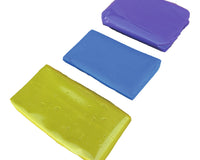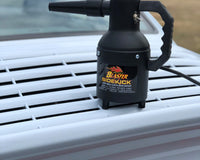Faded paintwork can diminish the overall appearance of a vehicle, leaving it looking tired and neglected. Fortunately, there are several techniques that can help restore the gloss and colour of faded paint, breathing new life into the vehicle's exterior. In this comprehensive guide, we'll explore these techniques in detail, providing valuable insights into how to achieve professional-quality results.
Understanding the Causes of Faded Paint:
Faded paint can result from various factors, including exposure to UV rays, environmental pollutants, improper washing techniques, and neglect. Before attempting to restore faded paint, it's essential to understand the underlying causes to address them effectively.
Preparing the Surface:
The first step in reviving faded paint is to prepare the surface properly. This involves thoroughly washing the vehicle to remove any dirt, grime, and contaminants that may be contributing to the fading. A gentle car shampoo and microfiber wash mitt should be used to avoid further damage to the paint.
Paint Decontamination:
Once the vehicle is clean, it's important to decontaminate the paint surface to remove embedded contaminants such as tar, sap, and industrial fallout. Clay barring is an effective technique for this purpose, as it gently lifts contaminants from the paint without causing scratches.

Paint Correction:
After decontamination, paint correction is necessary to address surface imperfections such as swirl marks, scratches, and oxidation. This can be achieved through machine polishing using a dual-action polisher and suitable polishing compounds. The goal is to restore clarity and smoothness to the paint surface.
Compounding:
For more severe paint defects, compounding may be required. Compounds are abrasive products designed to remove deeper scratches and oxidation, restoring the paint to a smoother, more uniform appearance. It's essential to choose the right compound for the specific needs of the paintwork.
Polishing:
Once the paint defects have been addressed, polishing is used to refine the finish and enhance gloss. Finer polishing compounds are used in this stage to remove any remaining haze and produce a high-gloss shine. Multiple polishing passes may be required to achieve the desired results.
Paint Protection:
After restoring the paintwork, it's crucial to protect it from future damage. Applying a high-quality paint sealant or ceramic coating provides a durable barrier against UV rays, environmental contaminants, and oxidation, helping to maintain the restored finish for longer.
Regular Maintenance:
To preserve the newly restored paintwork, regular maintenance is essential. This includes washing the vehicle regularly using safe washing techniques, applying a spray wax or quick detailer to boost shine and protection between washes, and storing the vehicle in a garage or covered area whenever possible.
Wet Sanding:
In cases where paint defects are severe or stubborn, wet sanding may be necessary. Wet sanding involves using a fine-grit sandpaper (typically 1500-3000 grit) along with lubrication to gently sand away imperfections. This technique requires skill and caution to avoid damaging the paint, and it is often best left to experienced professionals. Wet sanding can effectively remove deep scratches, orange peel texture, and other surface irregularities, resulting in a smoother and more uniform finish.
Paint Thickness Measurement:
Before embarking on any paint correction or restoration process, it's beneficial to measure the paint thickness to ensure that there is sufficient material to work with. Paint thickness gauges are specialized tools that provide accurate readings of the paint thickness on different areas of the vehicle. By measuring the paint thickness, detailers can determine the extent to which paint correction can be safely performed without compromising the integrity of the paint.
Paint Enhancement:
In some cases, a full paint correction may not be necessary, especially if the paint defects are minimal or if the vehicle's owner prefers a less intensive approach. Paint enhancement involves using lighter polishing techniques and products to improve the appearance of the paint without fully correcting all imperfections. While paint enhancement may not achieve the same level of perfection as paint correction, it can still significantly enhance the gloss and clarity of the paint.
Ceramic Coating Application:
For long-lasting protection and enhanced gloss, many car owners opt to apply a ceramic coating to their newly restored paintwork. Ceramic coatings form a durable, hydrophobic layer on the paint surface, repelling water, dirt, and contaminants while providing UV protection and chemical resistance. The application process involves meticulous surface preparation, including thorough cleaning and decontamination, followed by the precise application of the ceramic coating. Once cured, ceramic coatings offer years of protection and ease of maintenance.
Professional Detailing Services:
For optimal results, consider enlisting the services of a professional detailer who has the expertise and equipment to effectively revive faded paintwork. Professional detailing services can offer more advanced techniques and products, delivering showroom-quality results.
Ongoing Care and Maintenance:
Even after restoring and protecting the paintwork, ongoing care and maintenance are essential to preserve the results. This includes regular washing using pH-balanced car shampoos, using high-quality microfiber towels and wash mitts to avoid introducing swirl marks, and avoiding harsh chemicals or abrasive cleaners that could damage the paint or coatings. Additionally, periodic inspections and touch-ups can help address any new imperfections or areas of concern, ensuring that the paintwork remains in optimal condition for years to come.
Conclusion:
Reviving faded paintwork requires time, effort, and the right techniques, but the results are well worth it. By following the techniques outlined in this guide, you can restore the gloss and colour of your vehicle's paintwork, bringing back its original beauty and shine. With proper care and maintenance, your newly restored paintwork will continue to impress for years to come.




